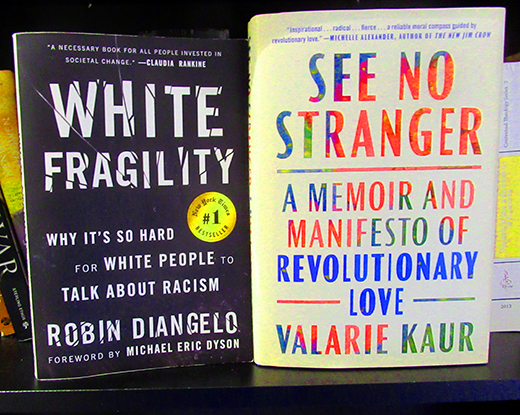Father Bob’s Bookshelf
August 24, 2020

by Father Robert Holmes, CSB
Two important reads during these “Black Lives Matter” days. My reflections are not so much a review of these books as a naming of a few of the learnings shared on the realities of white privilege and the difficult journey of practicing revolutionary love.
White Fragility by Robin DiAngelo, a white consultant and trainer on issues of racial justice, explains the challenges of talking to White People about racism. White folk consider their reality as normal, and in the United States, as a national identity. They often become defensive when white privilege is brought up in the conversation. As Michael Eric Dyson says in the Forward, this book is “a bracing call to white folk to see whiteness for what it is and to seize the opportunity to make things better now.”
See No Stanger by Valarie Kaur, activist, filmmaker, and civil rights lawyer, tells the story of her “tumultuous journey of awakening” as a Sikh born in the United States. She became an activist filmmaker in the aftermath of the 9/11 attack documenting the many racist retaliatory murders of turban-wearing Sikhs. She has dedicated her life to building movements of healing wounds and reimaging a world of “Revolutionary Love.” Her challenge, “What if this present darkness is not the darkness of the tomb, but the darkness of the womb!”
White Fragility: Why It’s So Hard for White People to Talk About Racism
DiAngelo encounters white fragility when she confronts white audiences with the fact that racism in the United States is a white problem deeply based on white privilege. The reactions she receives are emotional – fear, anger, guilt – and the responses are often argumentation, silence or exit. Their defensiveness is usually based on commonly accepted assumptions that racism is a personal prejudice, intentional discrimination, consciously perpetrated, and practiced by bad people. Claims of “colour-blindness” or “I have friends of colour” are put forward as exemptions from any personal responsibility for, or participation in, the problem – or its solution.
But racism is not about good people or bad people. It’s about inequality of power and cultural control. White privilege and white supremacy is never named. It’s assumed as normal. “White equilibrium is a cocoon of racial comfort, centrality, superiority, entitlement, racial apathy, and obliviousness, all rooted in being good people free of racism.” DiAngelo explains (pg. 112).
How then do we engage authentically in being part of the solution? Ask and listen to people of colour and be prepared to experience discomfort as we recognize our blind spots and our unconscious investments in racism. Discomfort is the key to growth. It is necessary and important, not to produce guilt but rather action. Seeing more clearly can move us to “break with white silence and white solidarity, to stop privileging the comfort of white people over the pain of racism for people of colour, to move past guilt into action.” (pg. 150). Our own liberation is bound up with theirs.
See No Stranger: A Memoir and Manifesto of Revolutionary Love
Kraus divides her memoir into three parts representing different stage in her life journey.
See No Stranger: Loving Others – Kaur describes her early days in rural California as a time of wondering about people, grieving with them, and choosing to fight for them. In Grade 8 her Sikh faith was shaken by a Christian girlfriend who told her she was going to hell but renewed in high school when a white Christian woman assured her that there were many paths to God. Following 9/11 she put her grief into action developing a college filmmaking project documenting beatings, stabbings, and shootings of Sikhs. And when the United States made plans to invade Iraq, she became a nonviolent warrior in opposition.
Tend the Wound: Loving Opponents – While at Harvard Divinity School and Yale Law School she learned that rage could be transformed by deep listening and lead to reimaging the world. Rage at police brutality experienced personally led her to collaborate with a priest and nun collecting stories of police abuse in East Haven, Connecticut. In law school she enrolled in projects at Guantanamo Bay, Cuba and a Supermax Prison in Connecticut listening to inmates, guards, lawyers, and families. In discussion with a man who was using a racial slur, she recognized the truth of Richard Rohr’s dictum, “Pain that is not transformed is transferred.”
Loving Ourselves: Breathe and Push – “We can care for ourselves by remembering the wisdom of the midwife: breathe and push. We can breathe to draw energy and power into our bodies and let joy in. We can push through fear and pain to become our best selves, including through healing, forgiveness, and reconciliation.” (pg. 314). Kaur put this into practice spending three months with a Sikh community in Wisconsin struggling to recover from suffering a mass murder. Revolutionary love pushes transition through healing, to freedom from hate, to forgiveness, to reconciliation. “Laboring in love is how we birth the world to come.”
Categories
Discerning, a Vocations BlogGeneral News
Stirrings
Uncategorized
Separated: Inside an American Tragedy
reflections by Father Robert Holmes, CSB Jacob Soboroff, a national news correspondent for NBC and MSNBC, was among the first journalists to expose the reality of the systematic separation of […]
Read MoreLearnings from The New Jim Crow: Mass Incarceration in the Age of Colorblindness
by Fr. Robert Holmes CSB The 10th Anniversary edition of Michelle Alexander’s The New Jim Crow could not be more timely. As Alexander says in her new preface, “Back in […]
Read MoreBob’s Book Shelf – September 2020
By Father Robert Holmes, CSB The 10th Anniversary edition of Michelle Alexander’s The New Jim Crow: Mass Incarceration in the Age of Colorblindness could not be more timely. As Alexander […]
Read More